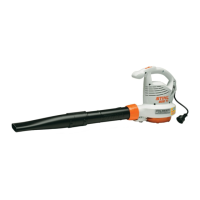BGE 61, BGE 71
English
5
Cord Sets
Appropriate extension cords are
available in special stores for electrical
equipment. Cords should be suitable for
outdoor use and marked "Suitable For
Use With Outdoor Appliances – Store
Indoors.“
Transporting the Electric Blower
Always switch off the motor before
putting down blower. When transporting
your unit in a vehicle, properly secure it
to prevent turnover and damage to the
machine.
Preparation for the Use of the Electric
Blower
Always check your electric blower for
proper condition and operation before
starting, particularly the power supply
cord, plug and switch.
Warning!
Special precautions for electric blowers
must be observed to reduce the risk of
personal injury and property damage
from fire and electric shock.
Warning!
When servicing, use only identical
replacement parts. Only authorized per-
sonnel should repair or replace dam-
aged cords. Never attempt unauthorized
repairs or open the powerhead.
Warning!
The voltage of the power supply must
agree with the voltage specified on the
blower’s machine label. Improper volt-
age will damage the blower and may
cause personal injury.
Warning!
Be sure switch is off when plugging the
unit into the power supply in order to
reduce the risk of fire or electrical shock
from arcing and the risk of injury from
unintended blowing.
Warning!
In order to reduce the risk
of serious injury from
electrocution, never use
your blower if the power
supply cord or plug is cut,
cracked, worn or dam-
aged.
Have a dealer replace such a power
supply cord.
Warning!
To reduce the risk of elec-
tric shock, do not use the
blower in damp or wet
locations. Do not use on
wet surfaces. Do not
expose to or use in rain.
Do not handle the plug or the unit with
wet hands.
Warning!
When using the electric blower, always
keep the power supply cord behind you.
Always ensure that your power supply
cord does not become entangled with
obstacles or objects. Damaged cables
may cause electrocution. Always dis-
connect the plug from the power supply
when you take a break.
Warning!
To reduce the risk of electric shock use
only extension cords that are intended
for outdoor use. Do not use damaged
extension cords. Examine extension
cord before using and replace if dam-
aged. When using an extension cord, be
sure to use one heavy enough to carry
the current your blower will draw. An
undersized extension cord will cause a
drop in line voltage resulting in loss of
power and overheating. The table in
chapter "Important Safety Precautions"
shows the correct gauge extension cord
to use depending on cord length for
120
Volt
power tools using 6 -10 amps.
Warning!
To reduce the likelihood of disconnec-
tion and the risk of electric shock,
always attach the extension cord to the
blower using the strain relief hook on the
handle as shown in the chapter entitled
"Connecting to Power Supply" in your
instruction manual.
Warning!
Avoid damage to the power supply cord
and extension cord. Keep cord away
from heat, oil and sharp edges. Never
carry blower by power cord or jerk
power cord to disconnect the plug from
the wall outlet. To unplug, grasp the plug
not the cord.

